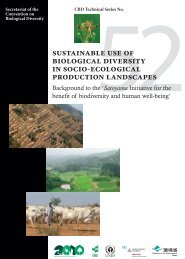INDIAN SCIENCE CONGRESS - India Environment Portal
INDIAN SCIENCE CONGRESS - India Environment Portal
INDIAN SCIENCE CONGRESS - India Environment Portal
Create successful ePaper yourself
Turn your PDF publications into a flip-book with our unique Google optimized e-Paper software.
8<br />
Proc. 98th <strong>India</strong>n Science Congress, Part II : Presidential Address<br />
The family Cantharellaceae was represented by 2 genera Cantharellus and<br />
Craterellus, each is further comprised of 5 and 2 species, respectively, and out of<br />
which one species each is new to science. Cantharellus cibrarius and C. minor<br />
and Craterellus cornucopoides are edible species and the former two are also<br />
mycorrhizal with Cedrus deodara. In the family Russulaceae, the genus Lactarius<br />
is represented by 14 species and Russula by 22 species and these include 4 species<br />
in the former and 5 new species in the latter. On the family Russulaceae very<br />
extensive work has been carried out at Punjabi University, Patiala by Saini and Atri<br />
(Saini and Atri, 1985a, b, 1984, 1985; Saini et al. 1982,1988,1989’ Atri and Saini<br />
1986, 1988, 1989 and 1990a, b, c; Atri et al. 1991a, b,c, d, 1992c,d 1993a They<br />
described 50 species of Russula from HP, in addition to Watling and Gregory<br />
(1980) and Rawla and Sarwal (1983). Bhatt et al. (1995) described 4 species of<br />
Russula from Uttrakhand. Eleven taxa are reported to be mycorrhizal with<br />
different trees species and 13 species are observed to be edible in literature out of<br />
which only Lactarius delicious, L. sanguifluus and Russula brevipes are the<br />
most favoured ones in the Himalayan region.<br />
The systematic work was further extended to families Agaricaceae,<br />
Hygrophoraceae, Pluteaceae and Tricholomatatceae (Lakhanpal, 1986; Kumar,<br />
1987). In the family Agaricaceae 6 genera have been recorded : Agaricus,<br />
Cystoderma, Lepiota, Macrolepiota, Leucoagaricus and Leucocoprinus. The<br />
last two were unrecorded from N. W. Himalaya earlier. In the genus Agaricus 8<br />
species are reported from N. W. Himalayas (Henning, 1900; Watling and Gregory,<br />
(1980; Singh and Mehrotra, 1974; Heinemann, 1968; Bakshi, 1974). Lakhanpal<br />
(1986) and Kumar (1987) described 4 species in this genus from Himachal<br />
Hiamalaya; Agaricus angustus Fr. , A. arvensis Schaeff. A. campestris L. ex. Fr.<br />
And A. placomyces Peck. Atri and his students have described around 25 species<br />
in the genus from different parts of Panjab and Dhancholia and Bahukhadi (1991)<br />
describe two species for Garhwal Himalaya.<br />
The genus Cystoderma was so far unrepresented from N. W. Himalayas.<br />
One species, C. amianthinum (Fr.) Fayod, has now been reported in the genus<br />
from N. W. Himalaya (Lakhanpal, 1986, Kumar, 1987). The species is mycorrhizal<br />
with Cedrus deodara.<br />
No species in the genus Lepiota was so far known from N. W. Himalayas.<br />
The two species known from the Himalayan region are from Eastern Himalayas.<br />
Lakhanpal (1986) and Kumar (1987) recorded three species in this genus : L.
















